Art Sets.
Wynne Prize 2022: children’s labels
Print this setBy the Art Gallery of NSW
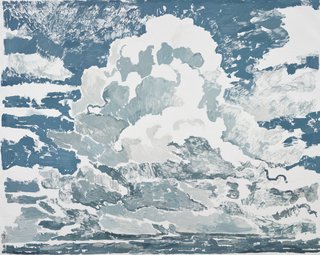
AGNSW prizes Clara Adolphs Christmas cloud, from Wynne Prize 2022
Describe the shapes in this billowing cloud formation.
Have you ever looked at clouds and imagined they are forming into recognisable shapes, perhaps of people or animals? Can you see any appearing here? Notice how Clara Adolphs has used thick and thin paint, and wet and dry brush marks. She has also scraped the paint across the surface of the canvas with a palette knife to capture the monumental size of the ever-changing clouds.
How quickly do you think Clara had to paint these clouds? Can you mimic her painting actions?

AGNSW prizes Julianne Ross Allcorn Implexis, from Wynne Prize 2022
How many different animals can you spot in this landscape?
The closer you look, the more animals you can see hidden among the plants along the water’s edge. Painted across four sliding wooden panels, this bustling bush habitat celebrates Julianne Ross Allcorn’s love of nature and how it changes with the seasons. Look at the different painting techniques Julianne uses to show texture and detail, from the scratchy lines of echidna spikes to the flicked spray of yellow paint around the wattle flowers.
What animals have been painted as silhouettes?

AGNSW prizes Wona Bae, Charlie Lawler Franklin River valley, lutruwita/Tasmania (topographic relief), from Wynne Prize 2022
Can you see the winding river in this circular artwork?
Wona Bae and Charlie Lawler have worked together to create this charcoal landscape. The river winds through the land in an ‘s’ shape. The charcoal has been cut and carefully placed to create the smooth surface of the water in contrast to the rock formations along the river’s banks. Notice how the charcoal appears shiny in some parts and matte in others. Can you see how some pieces have been cut to reveal their crystalline structure?
What different shapes can you see that have been placed together in a mosaic-like pattern?
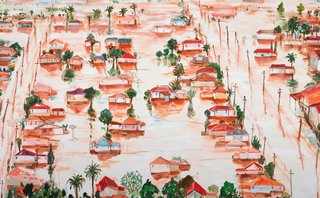
AGNSW prizes Geoff Harvey Lismore flood 2022, from Wynne Prize 2022
Have you ever lost something you cared about? How did it make you feel?
Geoff Harvey lost his Lismore home in the recent floods and painted this landscape as a way of dealing with his loss. Look at the lines of houses and how the colours of their roofs are reflected in the muddy floodwaters. Notice the lines of telegraph poles that indicate where the roads are, now hidden underwater. How many washing lines can you spot in the gardens?
Can you see any fences or hedges between the homes? How deep do you think the water might be?
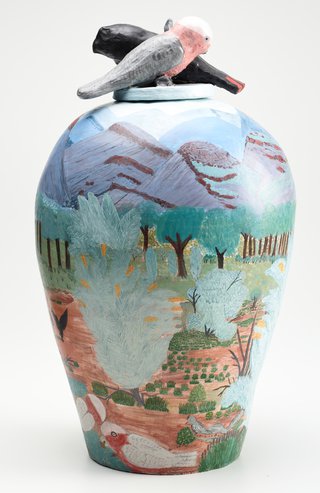
AGNSW prizes Hayley Panangka Coulthard Erraanta and elintja; Tnyam-iparta, from Wynne Prize 2022
Do you have a special place you like to go to for picnics or barbecues?
Hayley Panangka Coulthard likes to go for family picnics in the Sandhill Country near her home in the Northern Territory. The picnics are a time to teach children about Country, as they search for bush tucker. This large pot shows the features of the landscape, from the tall mountainous formations near the neck of the pot to the lines of trees and the rich red earth, and the small scrubs and bushes at its base. Walk around the pot and find all the different animals that Hayley’s family usually see while picnicking.
What birds form the handle of this pot?
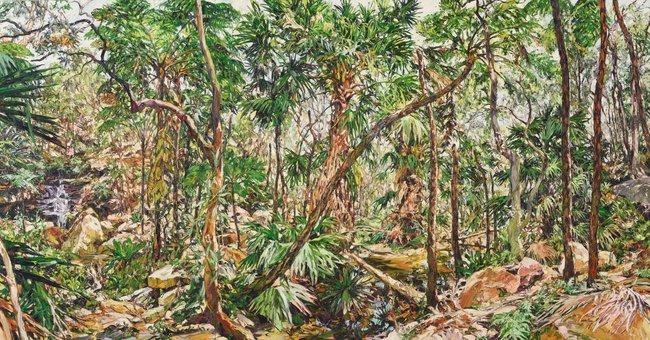
AGNSW prizes Nicholas Harding Eora, from Wynne Prize 2022
Notice the thick paint in this large landscape.
Nicholas Harding has applied thick strokes of oil paint with a palette knife to create a lush, green scene of trees, ferns, rocks and water. The palms and ferns fill the canvas so we can only see glimpses of the sky behind the dense bush and a waterfall to the left. The scale of the painting makes us feel like we are in the bush. What sounds do you think you would hear?
Nicholas has hidden little dragonflies in the painting. How many can you spot?
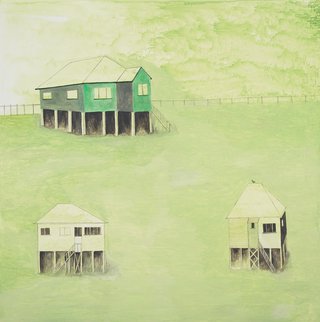
AGNSW prizes Noel McKenna 3 Queenslanders, from Wynne Prize 2022
Can you spot the tiny bird in this painting?
Noel McKenna grew up in a similar timber ‘Queenslander’ house to those in this painting. He enjoys painting their architectural details and the cement or wooden stumps that raise them up above the ground. Notice the dark shadows between the stumps under the houses, and how the one furthest away appears larger than others, creating an unusual sense of space and scale. There is no sign of life apart from the bird. The homes appear empty or deserted in the vast expanse of green that surrounds them.
What do you think has happened to the people who live here? Can you invent a story about them?

AGNSW prizes Betty Muffler Ngangkari Ngura (Healing Country), from Wynne Prize 2022
Which lines and shapes stand out the most in this large painting?
Betty Muffler has painted a special place near her home in the APY Lands of South Australia where emus come to drink at the waterholes. This place is also an important healing site, full of energy and spirits. The white lines of paint against the black background create their own bold energy and enhance the feeling of power that radiates from this land.
Can you spot the tracks left by the emus as they travel through Betty’s Country?

AGNSW prizes James Powditch Crowdy Head (after Peter Powditch), from Wynne Prize 2022
How many repeating sections can you see in this abstract landscape?
Vivid green quarter circles, or quadrants, repeat across the large rectangle. The quadrants are turned and placed in different formations, so they create new patterns or symmetrical shapes. The curves remind James Powditch of the harbour and headland of Crowdy Head in NSW. Notice how he has used corrugated card and paper collage to add textures and shapes to his landscape.
What shapes would you use to depict your favourite place?
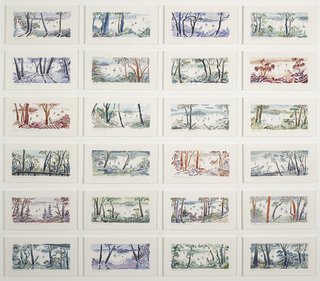
AGNSW prizes Gemma Rasdall Framed by life offshore, from Wynne Prize 2022
Gemma Rasdall lives on Scotland Island, a small island on Sydney’s Northern Beaches. She painted these watercolours to show how much she loves living there. The 24 tiny landscapes were painted on the island and they show a series of picturesque views as seen from some of her friends’ homes. How many balconies or fences can you find? (These give us clues as to where Gemma was when she painted the little scenes.) Try to spot the boats dotted around the bays.
Were the landscapes all painted at the same time of year? Are any of them of the same view?
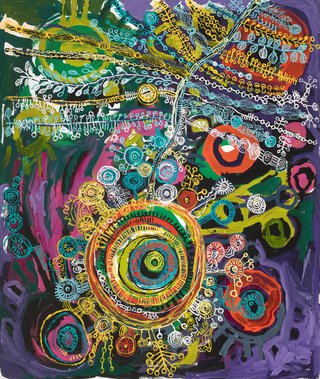
AGNSW prizes Sally Scales Wati Tjakura, from Wynne Prize 2022
How many different colours can you name in this painting?
Sally Scales is from the APY Lands in South Australia. This painting shows a special place for her family and a story about an edible skink lizard, Wati Tjakura. Look at all the circular shapes and leaf-like lines that cover the canvas. Notice how thick painterly brushstrokes have been applied in the background and how the circles and patterned lines have been applied over the top in bright or contrasting colours.
What colours would you use to paint a special place that you love?

AGNSW prizes Christophe Stibio LAKE MUNGO, 6:10AM, from Wynne Prize 2022
Look at the different materials and shapes in this bold landscape.
Christophe Stibio has applied shredded recycled paper strips on the surface of the canvas to emphasise the shape and curve of the undulating land and the salty formation of Lake Mungo, NSW. Can you spot fragments of printed text on the paper strips? Bold areas of red emphasise the dryness of the fossilised lake and the colour of sand, while blue lines create the effect of morning mist and haze over the formations formed over thousands of years.
What is the temperature like in this unusual landscape?
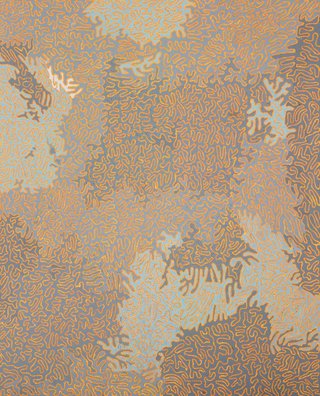
AGNSW prizes Tjapaltjarri Untitled, from Wynne Prize 2022
Which parts of this landscape do you think are water and which parts are land?
The creek and rockhole in this painting are in Western Australia. It is a place where Tingari women camp and collect the edible tubers of the silky pear vine. The lines that curl, weave and squiggle across the canvas show the root system of the plants. Find one line and follow it through the painting with your eyes. How far did you get?
Try following some more lines. How easy is it to follow them?
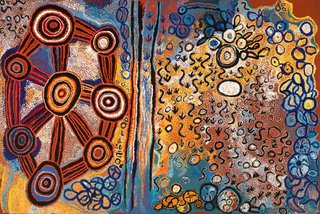
AGNSW prizes Umoona Senior Women’s Collaborative Nganampa Ngura (Our Country), from Wynne Prize 2022
Have you ever made an artwork with someone else?
This colourful artwork was created by three women from the same extended family. It shows important places near where they live in South Australia and important stories of their Country. Jeannie Minunga has painted a water serpent called Wanampi; Kay Finn has depicted waterholes; and Myra Kumantjara has painted features of the land at a women’s site. Notice how the colours and dots are layered and overlapped to create different colours and forms.
Which shapes stand out the most? Where do you think Wanampi is in the painting?